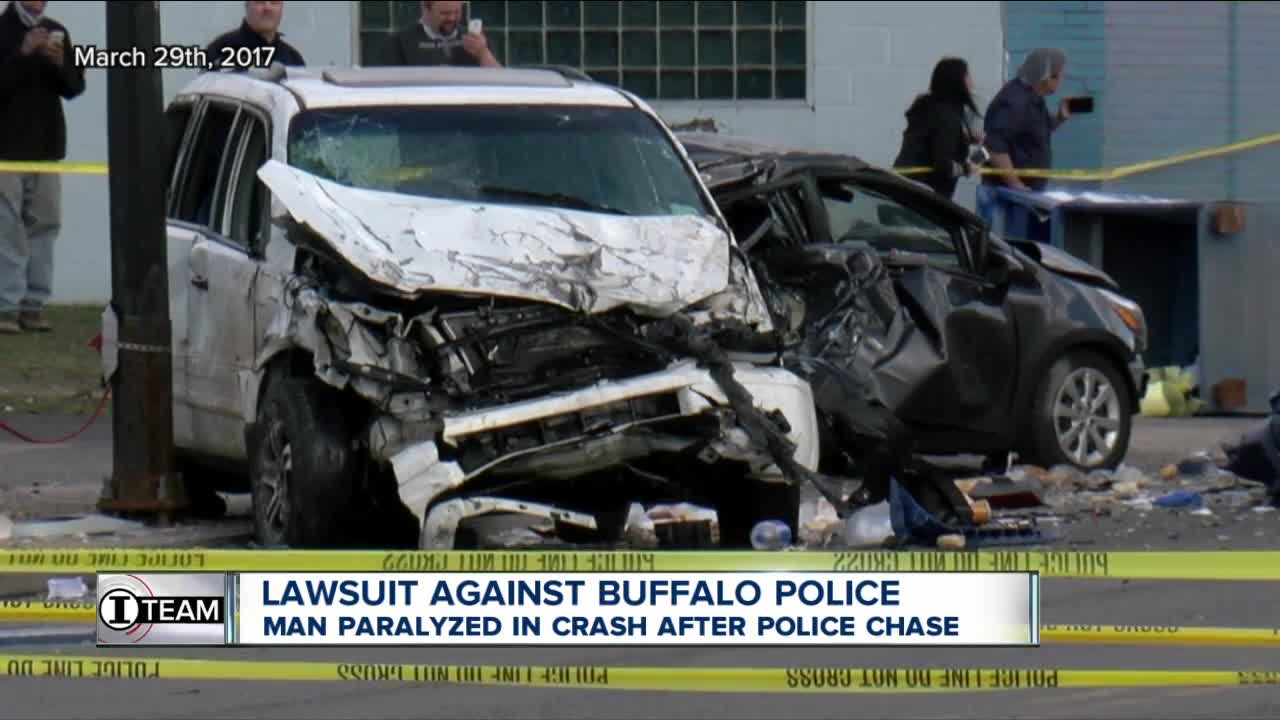BUFFALO, N.Y. (WKBW) — Buffalo Police officers violated department policy when they engaged in a high-speed chase last year that left a passenger in the car paralyzed from the neck down, a lawsuit filed in State Supreme Court alleges.
Attorney Frank Bogulski has sued the city -- as well as the police department, the officers who initiated the chase and the driver of the car that was trying to outrun police -- on behalf of Nikir Brown, who was critically injured in the Nov. 21, 2019 crash.
Brown was riding in the rear passenger seat of a 2005 Honda Accord driven by Marquel McCarley on Buffalo's East Side when police "began chasing the vehicle...because they noticed a tinted license plate cover," the lawsuit states.
The lawsuit alleges that in fleeing the police, McCarley's vehicle collided with a Toyota Camry and "as a result of the Defendants' negligence, Plaintiff Brown has been paralyzed from the neck down (C5 complete spinal cord injury)."
"He's a full quadriplegic," Bogulski said of Brown. "He's in bed, he can't walk. He's had very difficult time eating. His life will never be the same and he's irreparably harmed by this accident."
It's a crash that Bogulski says never should have happened -- because official police policy in most cases outlaws high speed chases for minor offenses.
The 7 Eyewitness News I-Team obtained the Buffalo Police Manual of Operating Procedures through a Freedom of Information Law request, and the policy states: "...vehicular pursuit of suspects in motor vehicles shall be limited to those circumstances in which the life or safety of any person is in imminent danger, or in which the person being pursued is suspected of having committed a violent felony. Even in these limited circumstances, the pursuit must be discontinued whenever the risk to the Officers or to the public engendered by the pursuit, outweighs the benefit of immediately apprehending the suspect."
Many police departments across the country have adopted similar policies as research has shown the impact of police chases on officers and innocent bystanders.
According to a recent analysis by USA Today:
- More than 5,000 bystanders and passengers have been killed in police car chases since 1979, and tens of thousands more were injured as officers repeatedly pursued drivers at high speeds and in hazardous conditions, often for minor infractions.
- The bystanders and the passengers in chased cars account for nearly half of all people killed in police pursuits from 1979 through 2013, USA TODAY found. Most bystanders were killed in their own cars by a fleeing driver.
Some police officers nationally have pushed back against such policies, stating that if they simply let drivers flee, lawlessness will ensue.
"With cameras, with all the surveillance that's out there, people aren't going to be able to run," Bogulski said. "The prudent thing for police would do would be to stop the chase and run the license plate, and then you could find the person later."
Citing the pending lawsuit, Buffalo Police officials declined to comment, but generally, police note that each case has to be judged individually, and factors such as time of day, weather and nature of the offense all factor into the decisions officers make out on the streets.
According to the police report from the 2019 crash, the vehicle was spotted with a tinted plate cover, but after police started following it, the vehicle stopped abruptly in front of a Curtiss Street home "where something was dropped from the vehicle."
McCarley, the driver of the vehicle, took off on foot before officers apprehended him, the report states. Police found crack cocaine and two empty pistol magazines, according to the report, but Brown's lawyer said the drug charge against Brown was dismissed.
It's not the only police pursuit that has garnered attention or controversy.
In 2017, one driver was seriously injured after the suspect hit two vehicles and then a school bus outside the Seneca Babcock Community Center. Six students suffered minor injuries, but police said the chase was justified because the vehicle struck a narcotics detective.
Earlier this month, five University at Buffalo students were injured when their vehicle collided with an Amherst police car that was on its way to a service call.
And the Buffalo Common Council recently agreed to pay a $4.5 million settlement to a man who was shot by police after a chase in 2012. Police said the man nearly struck police officers with his van.
"We want people to understand that the extreme risk that these high speed chases pose is definitely not worth it, especially when you're effecting a vehicle and traffic stop for such a minor offense," Bogulski said.



